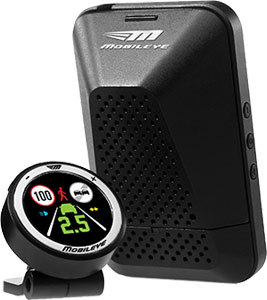Why Intel Mobileye?

As already reported , yesterday was published official information that Intel acquires Israeli company Mobileye , specializing in information tools for cars. This news reveals mainly financial and organizational aspects of the deal, but we want to highlight its technical aspects: what are Mobileye products, what is their history and what exactly Intel can get from Mobileye - both from a material point of view and from an ideological point of view ?
 The hardware platform for using Mobileye technologies is EyeQ’s own chip, which the company has been developing for 13 years, during which time three of their generations have changed. For the first two generations, the system was passive, that is, it informed the driver in certain situations: in traffic jams, when crossing the markings or when approaching dangerously with someone riding ahead, and so on. Due to the high specialization of the chip, it was possible to achieve its high performance on specific tasks, while maintaining low consumption.
The hardware platform for using Mobileye technologies is EyeQ’s own chip, which the company has been developing for 13 years, during which time three of their generations have changed. For the first two generations, the system was passive, that is, it informed the driver in certain situations: in traffic jams, when crossing the markings or when approaching dangerously with someone riding ahead, and so on. Due to the high specialization of the chip, it was possible to achieve its high performance on specific tasks, while maintaining low consumption. Since the third generation of EyeQ, released in 2014, Mobileye Advanced Driver Assistance System (ADAS) has acquired some active abilities, that is, it began to interact with the car without driver participation. At present, such functions as automatic emergency braking, adaptive cruise control, a strip following system and so on are introduced. As they say in the company, their system has become the eyes of the car.
Since the third generation of EyeQ, released in 2014, Mobileye Advanced Driver Assistance System (ADAS) has acquired some active abilities, that is, it began to interact with the car without driver participation. At present, such functions as automatic emergency braking, adaptive cruise control, a strip following system and so on are introduced. As they say in the company, their system has become the eyes of the car.')
Already, ADAS Mobileye can be installed on any car, including one not equipped with an on-board computer. The system consists of two devices: a unit with a camera and sensors (placed on the windshield) and a small round display (installed in any place convenient for the driver). Here you can learn a lot more about it.

In the picture above, you can see the EyeQ chip, the fourth generation - the production models of cars with its participation will appear at the end of this year. The SoQ EyeQ4 is manufactured using the 28-nm process technology and has 14 cores: 4 general-purpose MIPS architecture cores and 10 specialized vector accelerators for processing and recognizing video data. Of these 10 cores:
- 6 are vector microcode processors ( Vector Microcode Processors, VMP ) - VLIW SIMD processors, providing support for computer vision applications
- 2 cores of multithreaded processing cluster ( Multithreaded Processing Cluster, MPC ) - a powerful and universal computing tool
- The 2 cores of the Programmable Macro Programmable Macro Array (PMA) provide comparable performance with specialized accelerators, while remaining programmable.
EyeQ4 will be available in three versions: an initial one with one standard camera, advanced with trifocal camera support for semi-autonomous movement and a maximum one, supporting radar and laser range finders.
Currently, the fifth generation Mobileye system is being developed, which will become not only the eyes, but also the auto brain. It is on the basis of the creation of an autonomous vehicle that the interests of Mobileye and Intel have crossed - this cooperation we once wrote about. Now the work will become even more collaborative. So, in the end, got Intel? Undoubtedly, another component of the “Internet of Things” - without it, now does not do. But, if you dig deeper, you can find a more capital gain. Based in the field of unmanned vehicles, Intel will have access to huge amounts of data. Data is the main value of the present time and one of the main vectors of the company's development.
Intel wants to be where there is a lot of data. The acquisition of Mobileye gives it an almost dimensionless channel.
Source: https://habr.com/ru/post/402237/
All Articles